Grasshoppers have look-alikes in the form of katydids and crickets, which are both types of insects. These grasshopper doppelgangers share similar characteristics such as slender bodies, large hind legs, and the ability to produce ticking or clicking sounds by rubbing their wings together. Differentiating between grasshoppers, crickets, and katydids can be challenging due to these similarities.
However, there are distinct features that can help identify grasshoppers and their counterparts. Examining their size, body shape, antennae, behavior, and color can assist in distinguishing katydids, crickets, praying mantises, and stick insects from grasshoppers.
This guide aims to assist in identifying the differences between katydids, crickets, locusts, and other similar insects. If you have observed chirping insects hopping around your garden and desire to identify them, this article provides valuable information to determine whether they are grasshoppers or grasshopper look-alikes.
Insects That Resemble Grasshoppers
Certain insects bear a resemblance to grasshoppers due to their ability to leap using large hind legs, fly, or produce rapid tic-tic noises. Crickets and katydids are the two insect species that most closely resemble grasshoppers. However, stick insects and praying mantises also share similarities with certain grasshopper species, particularly the silent slant-faced grasshoppers.
Distinguishing between insects that share a similar appearance to grasshoppers becomes more perplexing when they possess similar common names. For instance, katydids are sometimes referred to as bush crickets and long-horned grasshoppers. However, bush cricket is also a subfamily of true crickets that resemble grasshoppers. Furthermore, these insects belong to the same insect order, Orthoptera.
How to Differentiate Grasshoppers, Katydids, and Crickets
There are several methods for distinguishing between similar-looking insects in the Orthoptera order.
One approach is to examine the antennae. Grasshoppers typically have short, thick antennae, while crickets and katydids possess long, thin antennae. Grasshoppers are predominantly active during daylight, whereas katydids feed at night. Crickets exhibit a more diverse habitat compared to grasshoppers or katydids.
Katydids (Tettigoniidae)
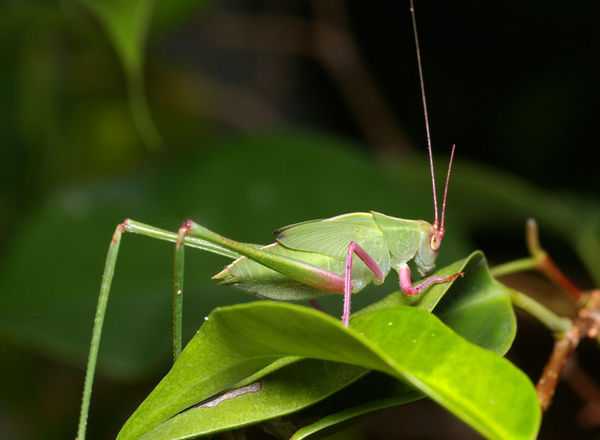
Katydids are green-winged insects that closely resemble grasshoppers in both appearance and sound. These grasshopper look-alikes have elongated, threadlike antennae, a pair of wings used for “singing,” and large, angled hind legs. Katydids primarily inhabit trees and are active exclusively at night, producing distinct sounds.
Certain katydids are enormous insects that can grow up to 5.1″ (130 mm) in length, surpassing the size of the world’s largest grasshopper. However, katydids can also be small green insects measuring as little as 0.20″ (5 mm). These grasshopper-like creatures are commonly found in tropical regions, although numerous species are native to North America.
To differentiate between katydids and grasshoppers, the primary distinction lies in their antennae. Katydids possess long, filamentous antennae that can exceed their body length, while grasshoppers have short, stubby antennae. Additionally, katydids are nocturnal, while grasshoppers are active during the daytime.
Katydids are also commonly known as bush crickets or long-horned grasshoppers.
Let’s examine specific species of katydids that resemble grasshoppers.
True katydids (Pseudophyllinae)

True katydids belong to various tribes of grasshopper-like insects in the subfamily Pseudophyllinae. These green insects exhibit a striking resemblance to leaves in terms of their appearance. Their large wings feature veins and blotches resembling tree leaves. Consequently, some katydids are referred to as leaf-mimic katydids.
Species within the subfamily Pseudophyllinae demonstrate significant variation. Some possess wings with gray and white mottled patterns, imitating dried, decaying leaves. On the other hand, other katydids bear resemblance to beautiful red butterflies, with yellow and deep red markings on their wings.
Meadow katydids (Conocephalinae)
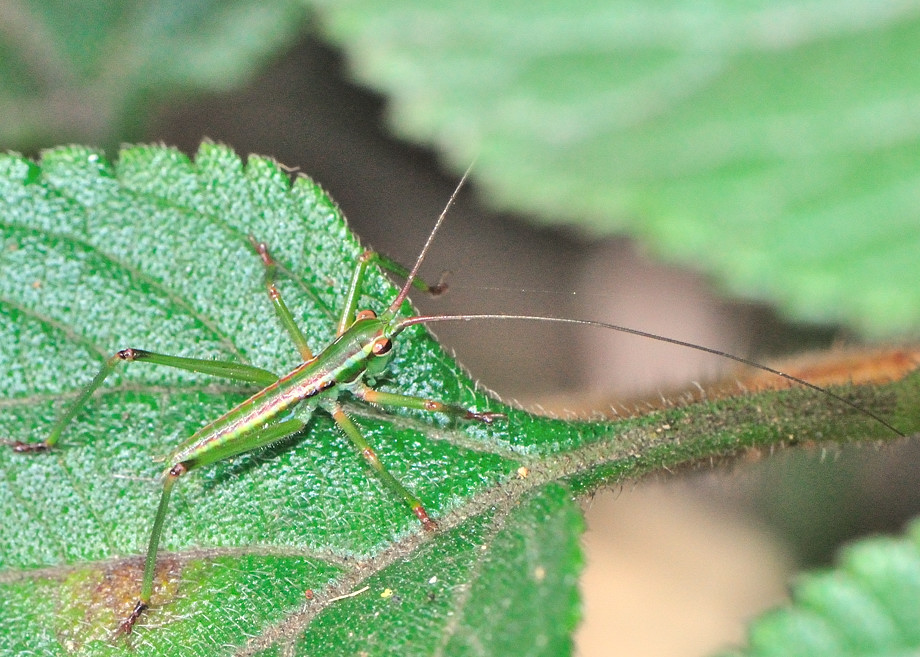
Meadow katydids closely resemble grasshoppers due to their slender bodies, large ‘V’-shaped hind legs, and vertically aligned heads. For instance, the long-winged conehead katydid (Conocephalus fuscus) features a saddle-shaped thorax, long forewings, and a distinctive stripe along its abdomen. This particular katydid species measures between 0.63″ and 0.87″ (16 – 22 mm) in length.
Among the various meadow katydid species, some insects resemble red grasshoppers (Eumacroxiphus brachyurus). These colorful katydids exhibit red abdomens, black-banded red legs, reddish-green wings, and exceedingly long threadlike antennae. However, the Orchelimum pulchellum is a green katydid with emerald-green wings and yellowish and red hind legs.
Predatory katydids (Saginae)

Numerous species of predatory katydids closely resemble gigantic grasshoppers, making differentiation challenging. The spiked magician (Saga pedo) bush cricket, for example, is a wingless insect characterized by its long, slender body and enormous hind legs. This katydid species boasts a dull green body and legs with a yellowish stripe along its abdomen.
Also referred to as the predatory bush cricket, the spiked magician measures a considerable 4.7″ (120 mm) in length. This makes it one of the largest katydids that resembles a grasshopper. These katydids inhabit pastures, meadows, shrubs, and grain fields.
True to their name, predatory katydids actively hunt their prey, and their diet consists of small insects.
Methods for removing katydids from the garden

While katydids do not typically cause extensive damage to plants, some individuals consider them unwelcome flying pests in gardens. For instance, the broad-winged katydid (Microcentrum rhombifolium) feeds on the foliage of citrus trees, potentially destroying immature species. These katydid insects may also nibble on citrus fruit peel.
The most effective approach to eliminate katydids when they become pests is to use spinosad early in the season to eradicate katydid nymphs. However, completely eradicating katydids from the garden proves challenging.
Crickets (Grylloidea)

Crickets, closely related to grasshoppers and katydids, are generally smaller, cylindrical insects with flattened bodies. Like katydids, crickets possess long, threadlike antennae and robust hind legs for leaping. They also produce chirping sounds. However, crickets have wings that are not adapted for flying, and as a result, they are typically ground-dwelling insects.
In North America, grasshopper look-alike crickets usually exhibit olive-green, brown, or black coloration. Most species feature a rounded head with large antennae and a pair of tail-like protrusions. These small insects generally measure between 0.47″ and 2.0″ (12 – 25 mm) in length.
Unlike grasshoppers, crickets have a wide distribution and can be found in most countries worldwide. They inhabit tropical and temperate regions, residing in bushes, forests, marshes, grasslands, and beaches.
Distinguishing crickets from grasshoppers involves several characteristics. Crickets possess an oval body and rounded head, whereas grasshoppers exhibit a more elongated body and a more robust head. Additionally, grasshoppers have short, stubby antennae, while crickets boast long antennae that typically exceed their body length. Furthermore, crickets cannot fly but scurry across the ground.
Let’s examine specific cricket species that may be mistaken for small grasshoppers.
Sword-tail crickets (Trigonidiinae)
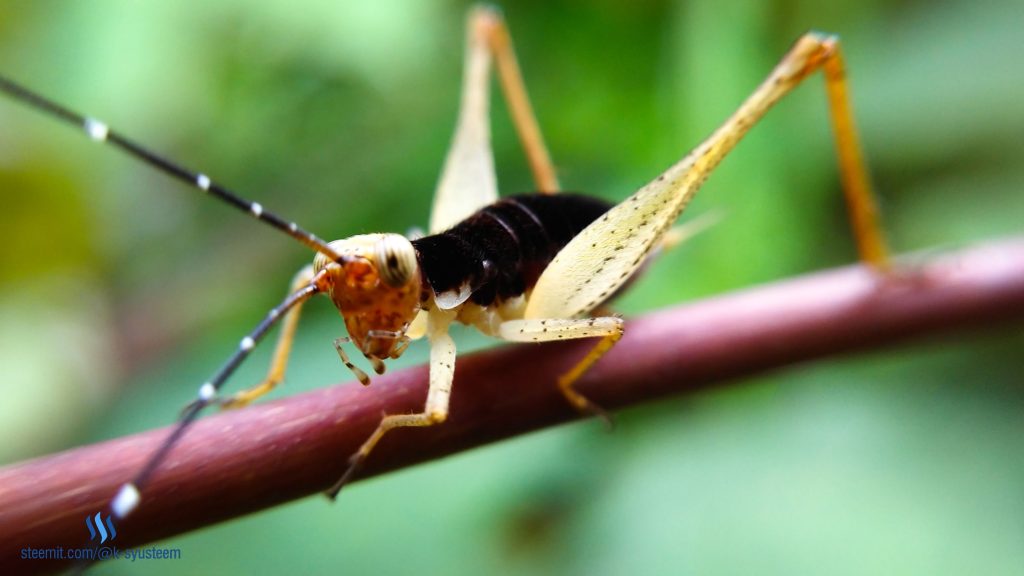
Also known as winged bush crickets or trigs, sword-tail crickets closely resemble small grasshoppers. These crickets feature large hind legs, long, wandering antennae, and an oval body. Depending on the species, they can exhibit black, brown, or yellowish-green coloration. Sword-tail crickets are prevalent throughout North America.
Typically, sword-tail crickets measure between 0.15″ and 0.35″ (4 – 9 mm) in length. They derive their name from the two pointed protrusions at the end of their abdomen. Other noticeable characteristics of sword-tail crickets include spines on their hind legs, large eyes, and colorful hind legs.
Ground crickets (Nemobiinae)
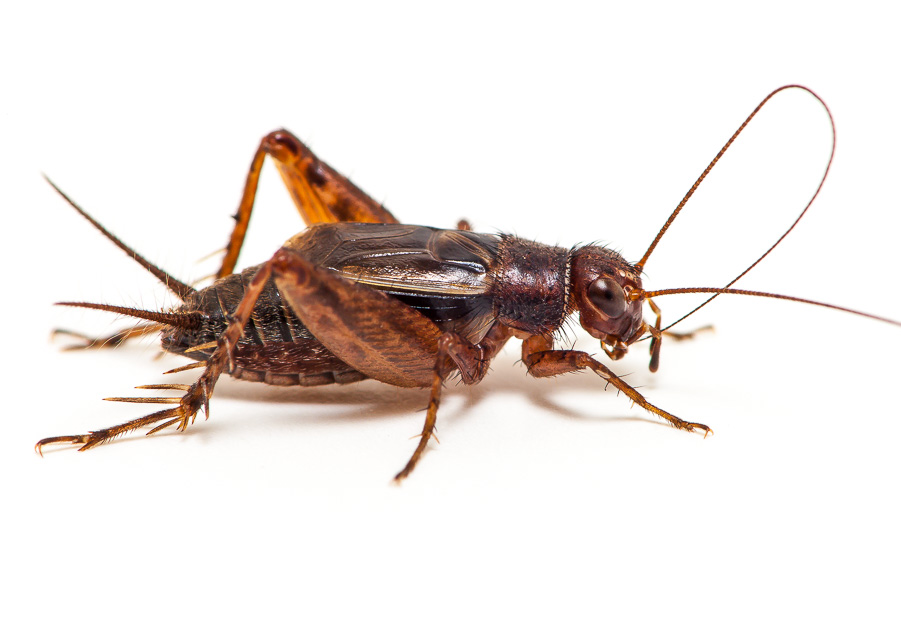
Ground crickets are small insects resembling tiny grasshoppers. Also referred to as wood crickets, these insects possess flattened, oval bodies, round heads, and two long antennae (although shorter than those of other crickets). Generally, ground crickets measure less than 0.6″ (15 mm) in length.
Omnivorous in nature, ground crickets are active during the daytime. The subfamily comprises around 200 species, most of which are small brown insects. This coloration enables them to blend seamlessly with leaf litter and the base of plants, their typical habitats.
Mole crickets (Gryllotalpidae)
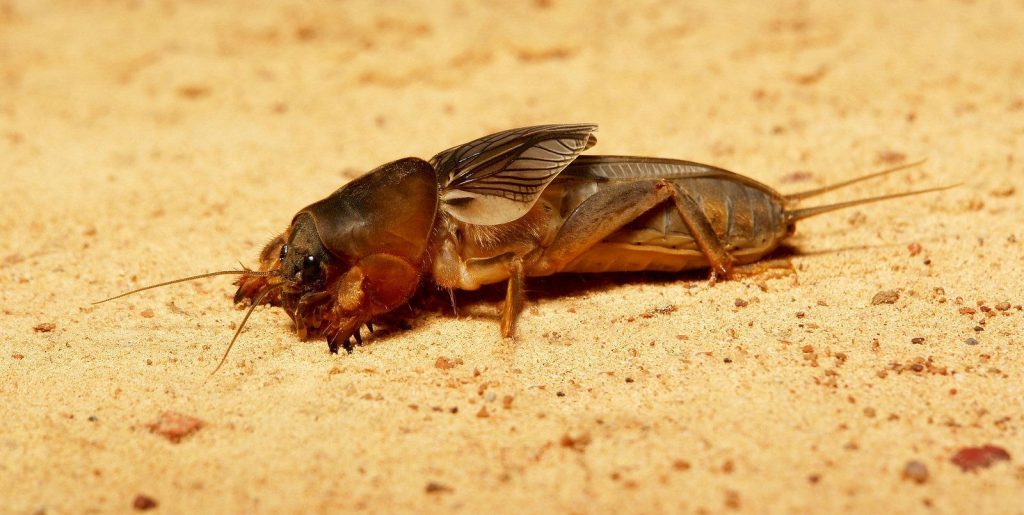
Mole crickets are a group of grasshopper look-alikes characterized by their cylindrical bodies, small eyes, and six legs. As the name suggests, mole crickets primarily inhabit underground burrows. These crickets exhibit a slender appearance, with relatively large heads and thoraxes. While their legs resemble those of true crickets, they are more adapted for pushing soil rather than leaping.
Mole crickets measure between 1.3″ and 1.4″ (3.2 – 3.5 mm) in length, making them mid-sized insects. An intriguing aspect of these crickets is their ability to fly. However, they spend the majority of their lives in underground burrows, where they feed, mate, and seek protection from predators. Mole crickets feed on other cricket species, larvae, roots, and worms.
Field crickets (Gryllus)
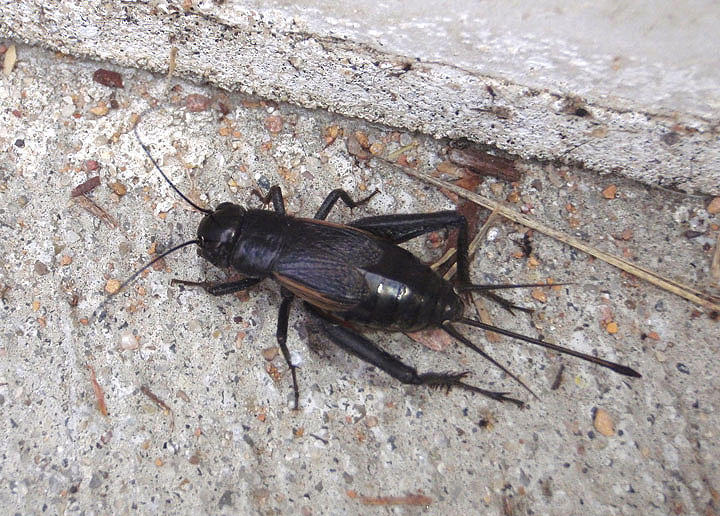
Field crickets are dark-colored insects that possess hind legs characteristic of grasshoppers. These crawling insects feature dark brown to black bodies, oval shapes, round heads, a pair of wings, and two pointed tails. They also possess spines or pegs on their rear legs, which they use to create chirping sounds.
Field crickets encompass hundreds of species, typically measuring between 0.59″ and 1.22″ (15 – 31 mm) in length. These crickets prefer sunny locations and thrive in dry conditions. As their name suggests, they primarily inhabit grasslands, where they feed on various types of grasses.
Bush Crickets (Eneopterinae)
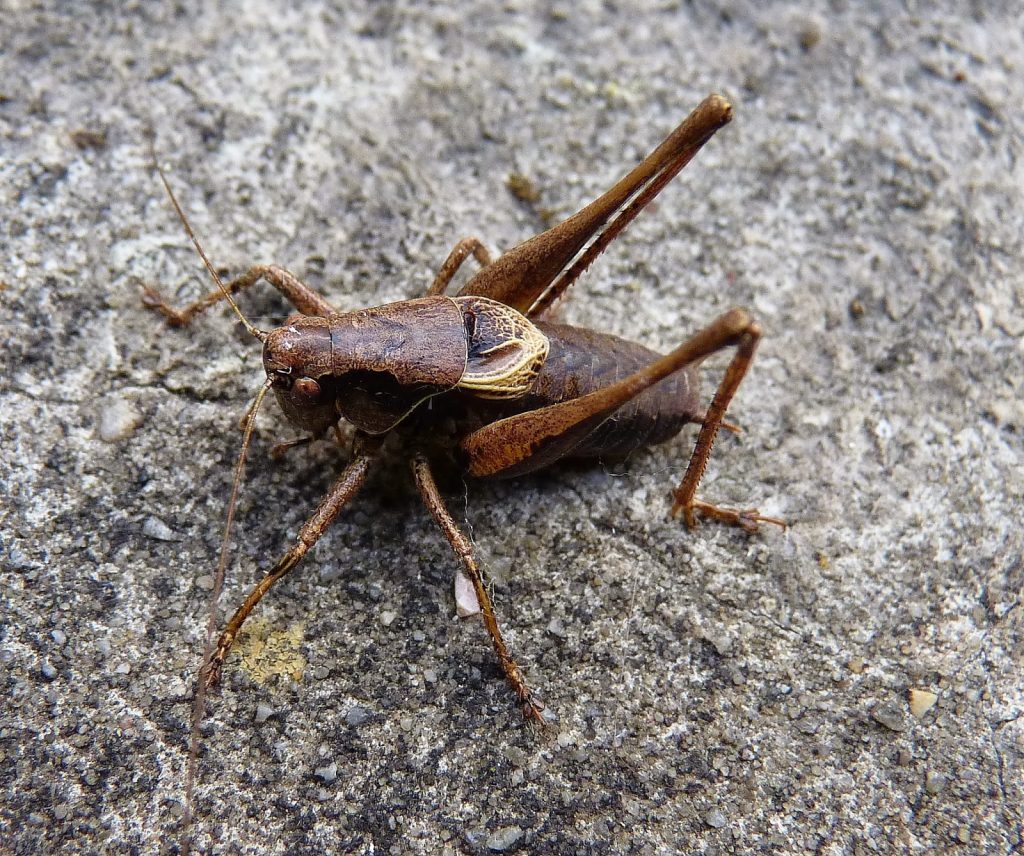
Bush crickets closely resemble grasshoppers in terms of body shape, hind legs, and vertically aligned heads. However, it is important to note that while katydids are also known as bush crickets, they are related but not identical species.
Locusts
Locusts closely resemble grasshoppers because they are, in fact, a type of grasshopper. Locusts belong to the species known as short-horned grasshoppers. They possess large hind legs, flight wings, and distinctive short antennae. What sets locusts apart from other grasshoppers is their gregarious phase, during which they undergo rapid multiplication and swarm in large numbers, sometimes reaching millions of individuals.
Swarms of locusts are relatively large insects, measuring up to 3.14″ (80 mm) in length. The desert locust, for example, is one of the largest flying grasshoppers. However, there are also smaller species of locusts, some measuring as little as 0.4″ (10 mm).
Let’s delve into the identifying features of some common locust species in more detail.
Migratory locusts (Locusta migratoria)
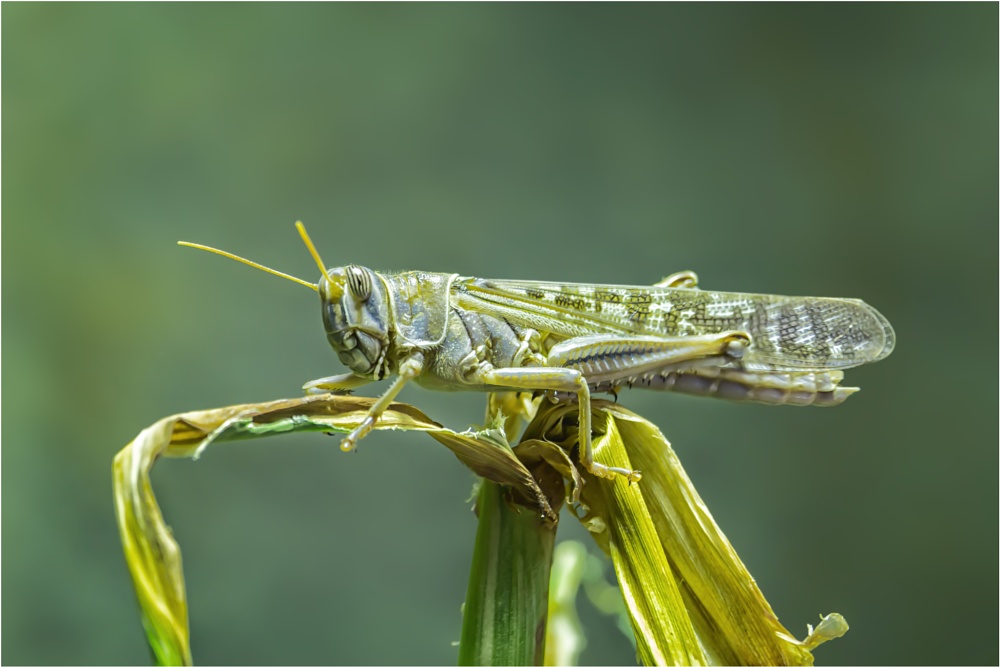
Migratory locusts are sizable insects with yellowish bodies and brown wings adorned with yellow patterns. These destructive pests possess large hind legs with dark brown to black ‘V’-shaped marks and small spikes. Like most locust species, they have short, straight antennae.
Migratory locusts range in size from 1.57″ to 2.36″ (40 – 60 mm) in length. They are commonly found in Africa and Asia. Similar to many locust species, the coloration of migratory locusts varies depending on their phase. In their gregarious adult phase, they exhibit a yellow-brown color, while their solitary phase showcases brown hues with patches of green.
Desert locusts (Schistocerca gregaria)

Desert locusts are large grasshoppers with an overall yellowish-green appearance. These destructive insects possess black patches on their wings, a bright yellow head and hind legs, and whitish-gray forelegs. However, during the gregarious phase, they develop pink patches. Like all grasshopper species, desert locusts feature short antennae.
Measuring approximately 3.14″ (80 mm) in length, desert locusts inhabit regions of Africa, Asia, and the Middle East. Swarms of these locusts can consist of tens of millions of individuals and cause extensive damage to crops.
Garden locusts (Acanthacris ruficornis)

Garden locusts are another large, short-horned grasshopper species prone to swarming behavior. These locusts exhibit dark brown wings, a yellowish-brown thorax and head, and a yellow stripe along their head and thorax. Their compound eyes display horizontal stripes, and they possess yellow and brown hind legs.
These enormous grasshoppers can reach lengths of up to 3.14″ (80 mm). Under favorable conditions, garden locusts are just as destructive as other swarming grasshopper species. They thrive in warm habitats and remain active throughout the year.
Stick Insects (Phasmatodea)

Stick insects represent a unique species of insect that closely resembles the silent slant-faced grasshopper. These extraordinary creatures possess long, cylindrical, stick-like bodies and elongated, outstretched legs. Typically, stick insects are either green or brown and possess wings, although they are unable to fly. Notably, stick insects possess remarkable camouflage abilities, enabling them to blend seamlessly with their surroundings.
Stick insects can be colossal, earning the distinction of being the world’s longest insects. The largest stick insect in the Phryganistria genus, for instance, reaches a length of 25″ (640 mm). However, some stick insects can be as tiny as 0.6″ (15 mm).
Also known as walking sticks, these leaf insects are found in temperate and tropical regions worldwide. They inhabit forests and woodlands, relying on their excellent camouflage to evade detection. Other names for stick insects include stick bugs, phasmids, ghost insects, and leaf bugs.
Praying Mantis (Mantodea)

The praying mantis is an intriguing green insect that can be mistaken for a large grasshopper. Praying mantises are easily recognizable due to their triangular heads with bulging eyes, elongated, slender bodies, and enlarged forelegs designed for grasping prey. Their name originates from their distinctive behavior of folding their forearms in a praying position when in an upright stance.
Praying mantises come in varying sizes, ranging from 2″ to 5″ (50 – 120 mm) in length. Although green is the typical coloration, they can also appear brown or yellowish-green. Praying mantises possess the ability to remain motionless for extended periods, but they adopt an aggressive pose when threatened, rising up on their hind legs and spreading their forearms.
Several praying mantis species are native to North America, with the Arizona mantis (Stagmomantis limbata) being prevalent in the southwestern United States. This pale-green-winged insect measures 3″ (75 mm) in length. On the other hand, the native Carolina mantis (Stagmomantis carolina) is a gray to dusty-brown insect found throughout the east coast.